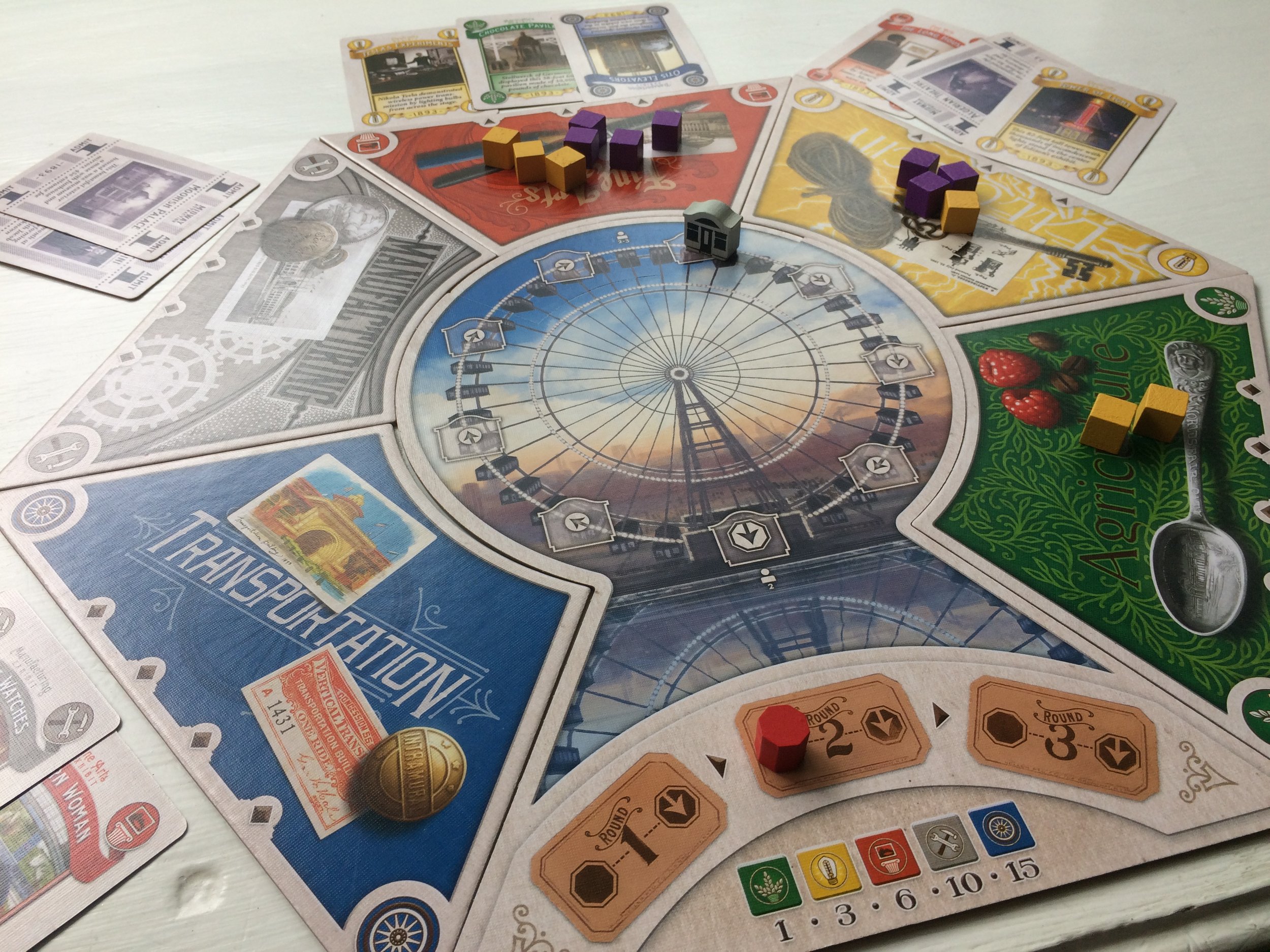Meaningful Decisions: J. Alex Kevern on Design Choices in World’s Fair 1893
/In our Meaningful Decisions series, we ask designers about the design choices they made while creating their games, and what lessons other designers can take away from those decisions.
In this edition, we talk with J. Alex Kevern, the designer World’s Fair 1893, about guiding and incentivizing players, cohesion in a design, identifying your audience, the development process, and more.
Players start World’s Fair 1893 with a certain number of supporters already on the board. They also receive a bonus based on where they are in turn order. Was this always the case, and how did you settle on the specific setup rules to get players into the meat of the game from the first turn?
In the initial prototype, players chose their starting spots in reverse turn order. For more experienced players this was a good solution, but for players new to the game, they would either choose a spot randomly, or agonize too long over it.
We decided the juice wasn’t worth the squeeze, so we settled on assigning the starting placements based on turn order. Those later in turn order get more “sole” majorities to start, and more placements on locations with lower card limits where there will be less future competition. This provided the needed balancing, without bogging down the start of the game.
What determines how much early guidance players should receive, without being too heavy-handed or too lax?
As designer I think the best thing you can do is make the value of things explicit. If you can clearly articulate what is rewarded in the game, players know what they are shooting for and they can fill in the gaps of how to get there themselves.
In World’s Fair 1893, the primary ways you earn points are by a) having majorities, and b) matching your exhibit cards to where you have those majorities. Players can then fill in the gaps and quickly figure out that placing a supporter in an area that contains an exhibit card of the same type is a good decision, especially if it also gives you majority there. I’ve found players often grasp this even on the first turn of their first game.
Where you need to be a bit more heavy-handed, like pre-determining the starting placements, is where the value of things is more obscured. There is inherent value in having your starting supporters in the Fine Arts and Electricity areas, as each of those locations can only hold up to three cards (as opposed to four in the other locations), so there are typically fewer supporters placed there over the course of the game--meaning more value for each supporter placed there. Given that’s not something less experienced players would be considering, it made sense to be more prescriptive with something like starting position.
Every turn, three cards are added to the board, but each location can hold a maximum of three or four cards. Why implement a cap rather than allow cards to continue stacking up at a location until a player takes them?
We did do some early testing without a cap, but it often led to too few interesting locations to choose from each turn. Once a location reaches three or four cards, it will always be a viable option for players to consider, so there wasn’t a reason to continue incentivising that spot, as it would end up being chosen within the next few turns anyway. It made more sense to improve the other locations, increasing their viability, and creating more interesting options for players to choose from.
How can a designer know when it's better to add hard restrictions and when it's better to let incentives guide the player experience?
Typically I think hard restrictions--like strict hand limit--are only necessary when not having one would a) potentially break the game, by pulling too many cards out of the deck, for instance, or b) ruin the experience for the other players playing in the spirit of the game. Otherwise, if you want to keep buying Copper cards in Dominion, for example, that’s fine--there are plenty in the supply, and it’s not impacting the other player’s ability to pursue their legitimate strategy, so you can just enjoy your coppery deck until the game ends.
However, if you do find you need to impose something like a hand limit, sometimes it can be enforced through a game mechanism rather than a strict rule. For example, there’s no explicit hand limit in Catan, but anytime you have more than seven cards, you must discard half of them when a 7 is rolled. Other games allow players to take cards from the player who has the most. So there are other ways of enforcing various “soft” limits on things, rather than simply putting a hard cap on it.
World's Fair 1893 went through an extensive development process after it was signed with Foxtrot Games. What core ideas guided that process?
We knew we wanted to make a gateway-style game, with cohesive mechanics and interesting decisions. The idea of cohesion guided a lot of the development process--for example, originally the cards that moved the ferris wheel “game timer” forward were something separate from the Midway cards. There were only nine or 10 of these “timer” cards, and the round would trigger once four were taken, which made round length far too variable (presumably, all four could come out in two turns). After trying a few different things, we discovered the solution of making the Midway cards the game timer--there were a few dozen of them in the deck, which meant that the round could end after 12 or so were taken, leading to a much more predictable round length. It also removed a whole superfluous element from the game, and created something that was much more cohesive.
It could have gone a different direction, where instead we could have added cards or mechanisms to make it work properly. But, because of the style of game we wanted to make, we were focused on a development process centered boiling down rather than building up.
What should a designer keep in mind during the development process? How can they know what to try to hold on to and what to let go?
The most important thing is articulating what you want the game to be, its purpose, and who is the intended audience. Developing a game that you are intending to be played by experienced hobby gamers will be very different than developing a game you want to be in the conversation for the Spiel des Jahres. If you can articulate what type of experience you are trying to create, from there you really just have to “listen to the game.” It will tell you what it needs--more player control, more long-term strategy, less analysis paralysis--and it’s up to you as the designer to listen to those signals the game is telling you and figure out what adjustments to make. Playtesters can help you listen and help you hear new and different things, but in the end you have to trust your ears, and follow the sound.
Cardboard Edison is supported by our patrons on Patreon.
ADVISERS: Rob Greanias, Peter C. Hayward, Aaron Vanderbeek
SENIOR INVENTORS: Steven Cole, John du Bois, Chris and Kathy Keane (The Drs. Keane), Joshua J. Mills, Marcel Perro, Behrooz Shahriari, Shoot Again Games
JUNIOR INVENTORS: Ryan Abrams, Joshua Buergel, Luis Lara, Neil Roberts, Jay Treat
ASSOCIATES: Dark Forest Project, Stephen B Davies, Adrienne Ezell, Marcus Howell, Thiago Jabuonski, Samuel Lees, Doug Levandowski, Nathan Miller, Mike Sette, S GO Explore, Matt Wolfe
APPRENTICES: Cardboard Fortress Games, Kiva Fecteau, Guz Forster, Scott Gottreu, Aaron Lim, Scott Martel Jr., James Meyers, The Nerd Nighters, Matthew Nguyen, Marcus Ross, Rosco Schock, VickieGames, Lock Watson, White Wizard Games














